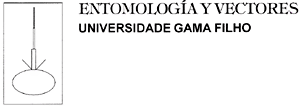Resumo em Português:
Programas de eletrificação rural em áreas isoladas, implantados com base em instalações fotovoltaicas e tradicionais, introduziriam um novo fator antrópico, que levantam suspeitas de associação à transmissão de doenças por culicídeos. Para testar atratividade de mosquitos por diferentes tipos de lâmpadas, foram utilizadas duas armadilhas tipo New Jersey, uma com lâmpada incandescente de 40 watts, e a outra, provida de bulbo fluorescente, compacta e com reator eletrônico de cor de igual intensidade luminosa, de 9 watts, com luz de temperatura de 6.200 K. Essas armadilhas operaram em duas áreas, em tempo e locais padronizados, totalizando 11 coletas, no período de janeiro a abril de 2002. Os resultados mostram que a lâmpada fluorescente atraiu 1,3 vezes mais culicídeos em relação à incandescente nas duas áreas. Foram coletados no total 806 espécimes, destacando-se: Aedes albopictus Skuse, 1894, Ochlerotatus scapularis (Rondani, 1848), Anopheles albitarsis Lynch Arribálzaga, 1878, Culex (Culex) nigripalpus Theobald, 1901, entre outros. Sugere-se que sejam realizados estudos antes da efetivação de programas de eletrificação rural para avaliar as conseqüências epidemiológicas desses empreendimentos.
Resumo em Inglês:
Rural electrification programs in remote areas based on both photovoltaic and traditional installations, could introduce a new anthropic factor, which is associated with Culicidae. To evaluate differences in mosquitoes attractiveness in relation to types of lamps two New Jersey traps were used: one with a 40 W incandescent lamp and the other with the same light intensity, a 9 W fluorescent bulb, compact, with an electronic reactor with 6.200 K of light temperature. The traps were set in two chosen areas according time and place previously established in a total of 11 collections from January and April 2002. The results show that the fluorescent lamp attracted 1,3 more culicidae than the incandescent lamp, in both areas a total of 806 specimens were collected including Aedes albopictus Skuse, 1894, Ochlerotatus scapularis (Rondani, 1848), Anopheles albitarsis Lynch Arribálzaga, 1878, Culex (Culex) nigripalpus, Theobald, 1901, among others. Studies should be carried out before the rural electrifications programs are implemented in order to evaluate the epidemiological consequences of such enterprises.
